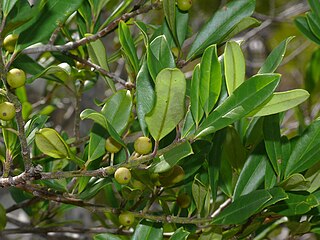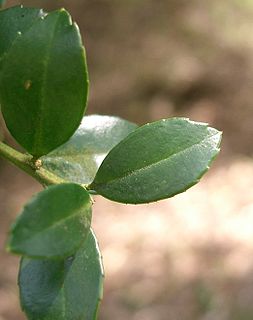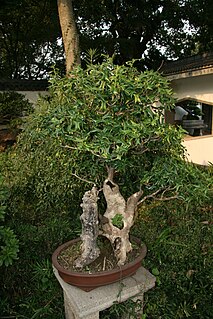
Quercus ilex, the evergreen oak, holly oak or holm oak, is a large evergreen oak native to the Mediterranean region. It takes its name from holm, an ancient name for holly. It is a member of the Cerris section of the genus, with acorns that mature in a single summer.

Ilex opaca, the American holly, is a species of holly, native to the eastern and south-central United States, from coastal Massachusetts south to central Florida, and west to southeastern Missouri and eastern Texas.

Ilex cassine is a holly native to the southeastern coast of North America, in the United States from Virginia to southeast Texas, in Mexico in Veracruz, and in the Caribbean on the Bahamas, Cuba, and Puerto Rico. It is commonly known as dahoon holly or cassena, the latter derived from the Timucua name for I. vomitoria.

Ilex vomitoria, commonly known as yaupon or yaupon holly, is a species of holly that is native to southeastern North America. The word yaupon was derived from the Catawban yą́pą, from yą- tree + pą leaf. Another common name, cassina, was borrowed from Timucua. The Latin name comes from an incorrect belief by Europeans that the plant caused vomiting in certain ceremonies.

Ilex verticillata, the winterberry, is a species of holly native to eastern North America in the United States and southeast Canada, from Newfoundland west to Ontario and Minnesota, and south to Alabama.

Ilex crenata is a species of holly native to eastern China, Japan, Korea, Taiwan, and Sakhalin.

Ilex aquifolium, the holly, common holly, English holly, European holly, or occasionally Christmas holly, is a species of flowering plant in the family Aquifoliaceae, native to western and southern Europe, northwest Africa, and southwest Asia. It is regarded as the type species of the genus Ilex, which by association is also called "holly". It is an evergreen tree or shrub found, for example, in shady areas of forests of oak and in beech hedges. In the British Isles it is one of very few native evergreen trees. It has a great capacity to adapt to different conditions and is a pioneer species that repopulates the margins of forests or clearcuts.

Ilex mucronata, the mountain holly or catberry, is a species of holly native to eastern North America, from Newfoundland west to Minnesota, and south to Maryland and West Virginia.

Ilex guayusa is a species of tree of the holly genus, native to the Amazon Rainforest. One of three known caffeinated holly trees, the leaves of the guayusa tree are dried and brewed like a tea for their stimulative effects.

Kuding or kuzding is a particularly bitter-tasting Chinese infusion, which due to their similarities in appearance is derived from several plant species. The two most common plants used to make kuding are the wax tree species Ligustrum robustum and the holly species Ilex kaushue, the former being more commonly grown in Sichuan and Japan while the latter is most commonly grown and used in the rest of China. This type of tea may be caffeinated if from the genus Ilex, but is caffeine-free if from the genus Ligustrum.

Salix integra is a species of willow native to northeastern China, Japan, Korea and Primorsky Krai in the far southeast of Russia.

Prunus ilicifolia It is native to the chaparral areas of coastal California, Baja California, and Baja California Sur. as well as the desert chaparral areas of the Mojave desert.

Ilex decidua is a species of holly native to the United States.

Osmanthus heterophyllus, variously known as holly osmanthus, holly olive, and false holly, is a species of flowering plant in the olive family Oleaceae, native to eastern Asia in central and southern Japan and Taiwan.

Ilex latifolia is a species of holly, native to southern Japan and eastern and southern China, growing in broadleaf forests at altitudes of 200–1,500 m.

Ilex amelanchier, the swamp holly or sarvis holly, is a rare species of holly from the southeastern United States. It is a close relative of mountain holly which used to be placed in a monotypic genus Nemopanthus. Ilex amelanchier grows near water, for example on streambanks.

Ilex, or holly, is a genus of about 480 species of flowering plants in the family Aquifoliaceae, and the only living genus in that family. The species are evergreen or deciduous trees, shrubs, and climbers from tropics to temperate zones worldwide.

Ilex cornuta, commonly known as Chinese holly or horned holly, is a slow-growing, densely foliaged evergreen shrub in the Aquifoliaceae plant family. It is native to eastern China and Korea and attains a height of about 3 metres (9.8 ft). The leaves are usually 5-spined, between 3.5 cm and 10 cm long, oblong and entire. The fruits are red berries, which are larger than those of the European Holly.

Ilex ambigua is a species of flowering plant in the holly family known by the common names Carolina holly and sand holly. It is native to the southeastern and south-central United States, along the coastal plain from North Carolina to Texas, inland as far as Oklahoma, Arkansas, and Tennessee.

Ilex rotunda, commonly called the Kurogane holly, is an evergreen tree in the holly family (Aquifoliaceae). It is native to east Asia, where it is found in China, Japan, Korea, Taiwan, and Vietnam. Its natural habitat is in evergreen broadleaf forests, often in sunny areas such forest edges or on mountain slopes.





















